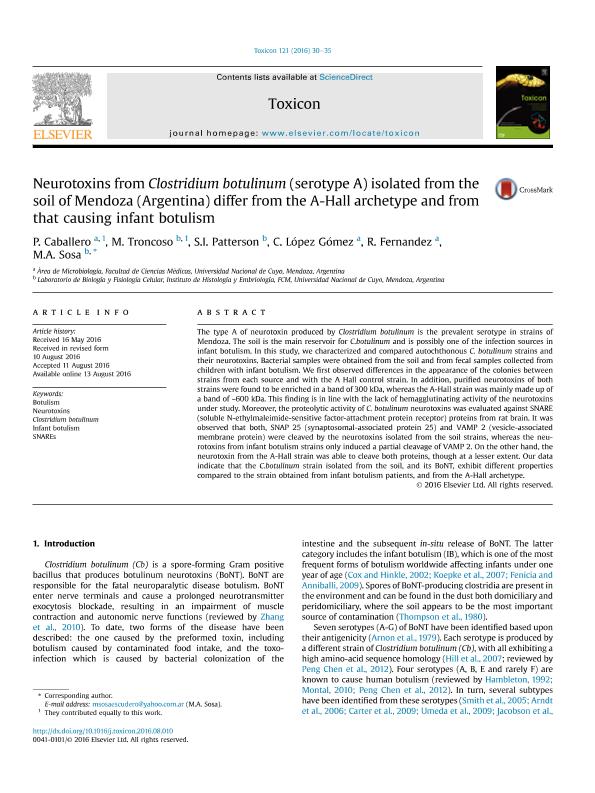Artículo
Neurotoxins from Clostridium botulinum (serotype A) isolated from the soil of Mendoza (Argentina) differ from the A-Hall archetype and from that causing infant botulism
Caballero, P.; Troncoso, Mariana Elizabeth ; Patterson, Sean Ingram
; Patterson, Sean Ingram ; Lopez Gomez, C.; Fernandez, R.; Sosa Escudero, Miguel Angel
; Lopez Gomez, C.; Fernandez, R.; Sosa Escudero, Miguel Angel
 ; Patterson, Sean Ingram
; Patterson, Sean Ingram ; Lopez Gomez, C.; Fernandez, R.; Sosa Escudero, Miguel Angel
; Lopez Gomez, C.; Fernandez, R.; Sosa Escudero, Miguel Angel
Fecha de publicación:
10/2016
Editorial:
Pergamon-Elsevier Science Ltd
Revista:
Toxicon
ISSN:
0041-0101
Idioma:
Inglés
Tipo de recurso:
Artículo publicado
Clasificación temática:
Resumen
The type A of neurotoxin produced by Clostridium botulinum is the prevalent serotype in strains of Mendoza. The soil is the main reservoir for C.botulinum and is possibly one of the infection sources in infant botulism. In this study, we characterized and compared autochthonous C. botulinum strains and their neurotoxins. Bacterial samples were obtained from the soil and from fecal samples collected from children with infant botulism. We first observed differences in the appearance of the colonies between strains from each source and with the A Hall control strain. In addition, purified neurotoxins of both strains were found to be enriched in a band of 300 kDa, whereas the A-Hall strain was mainly made up of a band of ∼600 kDa. This finding is in line with the lack of hemagglutinating activity of the neurotoxins under study. Moreover, the proteolytic activity of C. botulinum neurotoxins was evaluated against SNARE (soluble N-ethylmaleimide-sensitive factor-attachment protein receptor) proteins from rat brain. It was observed that both, SNAP 25 (synaptosomal-associated protein 25) and VAMP 2 (vesicle-associated membrane protein) were cleaved by the neurotoxins isolated from the soil strains, whereas the neurotoxins from infant botulism strains only induced a partial cleavage of VAMP 2. On the other hand, the neurotoxin from the A-Hall strain was able to cleave both proteins, though at a lesser extent. Our data indicate that the C.botulinum strain isolated from the soil, and its BoNT, exhibit different properties compared to the strain obtained from infant botulism patients, and from the A-Hall archetype.
Palabras clave:
Botulism
,
Clostridium Botulinum
,
Infant Botulism
,
Neurotoxins
,
Snares
Archivos asociados
Licencia
Identificadores
Colecciones
Articulos(IHEM)
Articulos de INST. HISTOLOGIA Y EMBRIOLOGIA DE MEND DR.M.BURGOS
Articulos de INST. HISTOLOGIA Y EMBRIOLOGIA DE MEND DR.M.BURGOS
Citación
Caballero, P.; Troncoso, Mariana Elizabeth; Patterson, Sean Ingram; Lopez Gomez, C.; Fernandez, R.; et al.; Neurotoxins from Clostridium botulinum (serotype A) isolated from the soil of Mendoza (Argentina) differ from the A-Hall archetype and from that causing infant botulism; Pergamon-Elsevier Science Ltd; Toxicon; 121; 10-2016; 30-35
Compartir
Altmétricas



